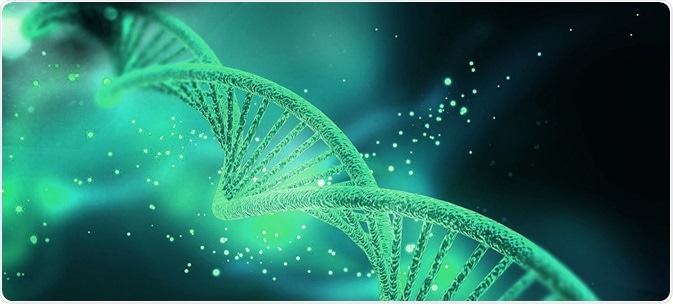Severe Combined Immunodeficiency (SCID) is a rare genetic condition characterized by a lack of B- and T-lymphocytes, which form part of the adaptive immune system. SCID is most often inherited in an autosomal recessive fashion.
 Gene Therapy for Severe Combined Immunodeficiency (SCID)" />
Gene Therapy for Severe Combined Immunodeficiency (SCID)" />
Credit: Hamdee/Shutterstock.com
Immunologically, compromised infants become prime targets for numerous life-threatening infections. Till date, fourteen different types of SCID have been identified, the most common being X-linked SCID (XSCID), which is caused by a mutation in the IL2RG gene on X-chromosome. Other possible loci for SCID-related mutations are adenosine deaminase (ADA), JAK3 pathway, alpha chain of interleukin (IL)-7receptor, CD3, CD45 chains etc.
SCID was traditionally diagnosed after the development of several lethal recurrent infections. However, with the advent of awareness and advanced techniques, SCID can be diagnosed during pregnancy, through the analysis of prenatal (of a fetus) or post-natal DNA sequencing, which can be performed much before the onset of infections. Other economic and simpler method of identification is by differential blood cell counting soon after the birth. Timely diagnosis and treatment can make a life-saving difference.
Provisional treatment options
Due to a compromised immune system, infants with SCID develop infections even when they are administered with the vaccines containing weakened viruses or bacteria. Therefore, unlike other infants, the immunity of SCID patients cannot be strengthened by administration of vaccines. For patients with severe infections, doctors may primarily give antibiotics to treat the infections however; it does not treat the underlying condition (SCID).
While carrying out blood transfusion to the patient with SCID, the foreign lymphocytes can attack the body of the host due to poor immune defense. Therefore, the blood being transfused should be made free from lymphocytes through radiation. Even though not being an absolute cure, physicians also often administer immunoglobulins via intravenous infusion to help build the body’s defense mechanism.
The patients with specifically identified enzyme deficiency such as ADA deficiency SCID may receive enzyme replacement therapy employing periodic injections of the deficient enzyme. Despite being an expensive lifelong intervention, it is practiced due to the lack of other viable options in many cases.
Stem cell transplantation for SCID
To date, the most effective cure for SCID is stem cell transplantation. Stem cells are usually taken from the bone marrow or other blood components of a related donor with matching tissue type. The transplanted stem cells, once adapted, form healthy T and B-cells inside the body of the host which further multiply on their own.
A perfect HLA-type matched sibling is an ideal choice as a donor, however if an ideal match is not available, the stem cells can also be transplanted from an unrelated or partially related donors, albeit with lesser success ratio. Transplantations carried out within first three months after birth have been reported to be the most successful. Hence, the timely diagnosis and donor identification are of paramount importance.
Gene therapy for SCID
In the past few years, gene therapies for SCID have been explored. It involves the isolation and molecular correction of mutations in the patients own haematological stem cells, followed by transplantation of the functional cells back into the patient.
Retroviruses are commonly employed as the vectors for gene therapy, due to their unique ability to penetrate the cells of the patients. Firstly, after identifying the locus of gene mutation, a healthy replica of the defective gene is prepared. Retroviruses are emptied of their own genome, and the healthy replica of the defective human gene is then inserted into the retrovirus shell.
Faulty stem cells isolated from the SCID patient are then inoculated with retrovirus containing healthy human gene of interest. Incubation in favorable growth conditions ensures insertion and proliferation of healthy human gene inside the stem cells of the patient, which are then transplanted back into the body after washing off the virus from the cells. These “corrected” version of cells further divide and proliferate, passing on the normal gene copies to all the blood cells eventually.
In this way, the gene therapy can cure the ailment by correcting the root cause of the disease. The additional advantage is that it does not warrant a compatible donor and also almost nullifies the possibility of host versus graft reactions.
The results of clinical trials with gene therapies have been outstanding, with significant long-lasting reinforcement of immune strength. While the children with XSCID and ADA deficiency SCID were largely cured with gene therapies, unfortunately few of them were reported to have developed leukemia.
Outlook for gene therapy
The effectiveness of gene therapy means it is now used treat several primary immunodeficiency diseases. However, in recent years, some of these treatments and trials have been halted, due to concerns over the safety of viral vectors.
This has led to many organizations across the world working towards the development of safer gene variants and techniques. It is hoped that the safety issues will be addressed in the near future and more promising gene therapy methods will be made available to treat several types of SCID.
Sources:
- http://www.scid.net/
- https://www.ncbi.nlm.nih.gov/books/NBK22254/
- https://www.genome.gov/13014325/learning-about-severe-combined-immunodeficiency-scid/
- https://kidshealth.org/en/parents/severe-immunodeficiency.html
- http://www.aaaai.org/conditions-and-treatments/primary-immunodeficiency-disease/severe-combined-immunodeficiency
- primaryimmune.org/treatment-information/stem-cell-and-gene-therapy
Further Reading